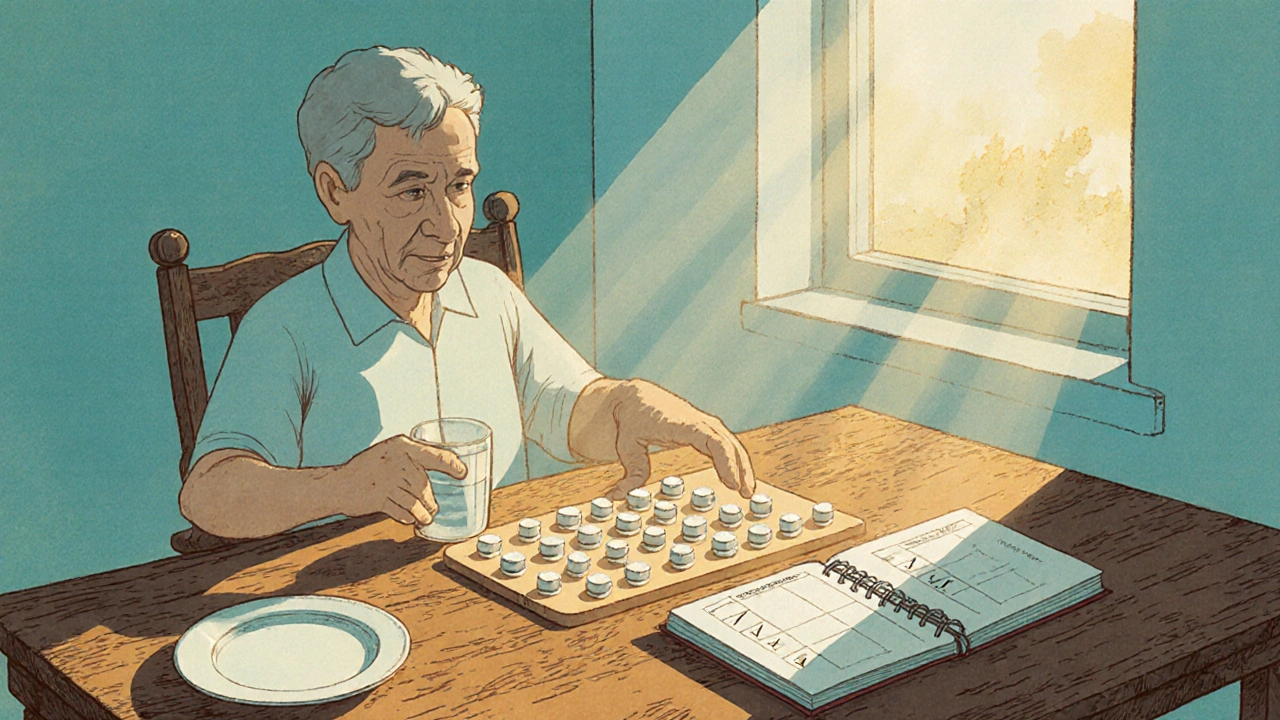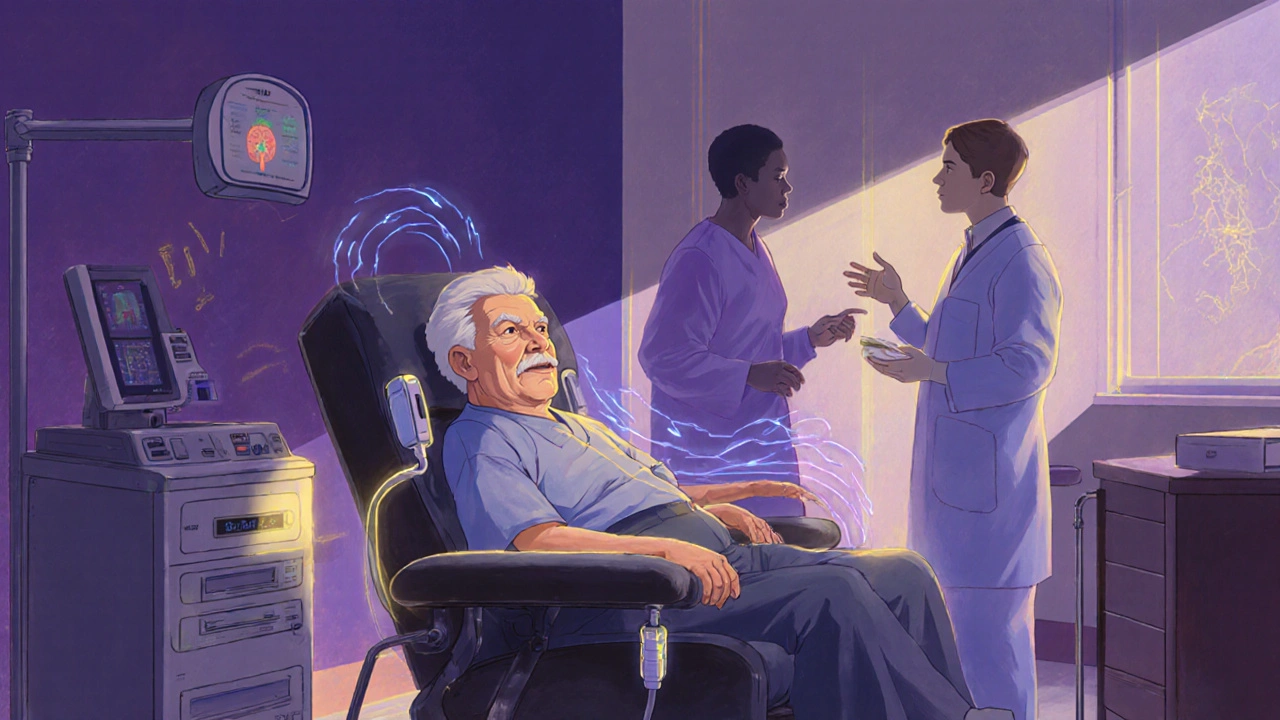Parkinson's Treatment Stage Guide
Select Your Parkinson's Stage
This tool recommends appropriate treatment strategies based on your disease stage
Select a stage to view recommendations
This guide will show you optimal treatment strategies for each Parkinson's disease stage.
Trying to figure out how carbidopa-levodopa fits into each phase of Parkinson’s disease can feel like solving a puzzle with pieces that keep moving. Below you’ll get a clear picture of what the drug does, how the disease progresses, and which dosing tweaks or extra therapies can keep symptoms in check at every stage.
Key Takeaways
- Carbidopa‑levodopa remains the cornerstone for motor symptom control in Parkinson’s disease.
- Early‑stage patients often start with low doses and may combine with MAO‑B inhibitors.
- Mid‑stage disease usually needs dose titration and timing adjustments to manage “wearing‑off” periods.
- Advanced PD may require adjuncts like COMT inhibitors, dopamine agonists, or device‑based therapies.
- Proactive monitoring of motor fluctuations and dyskinesia helps preserve quality of life.
What Is Carbidopa-Levodopa?
Carbidopa-Levodopa is a combination drug where levodopa supplies the brain with dopamine, while carbidopa blocks its premature conversion in the bloodstream, allowing more levodopa to reach the brain. The result is smoother, more predictable relief of tremor, rigidity, and bradykinesia.
Brief Overview of Parkinson’s Disease Stages
Parkinson's disease is a progressive neurodegenerative disorder characterized by the loss of dopamine‑producing neurons in the substantia nigra. Clinicians typically break the disease into four stages:
- Stage1 (Early): Symptoms are mild and usually affect one side of the body.
- Stage2 (Mild‑moderate): Bilateral symptoms appear, but daily living remains largely independent.
- Stage3 (Moderate): Balance issues emerge; falls become more common.
- Stage4‑5 (Advanced): Mobility is severely limited; patients may need a wheelchair or need constant care.

How Carbidopa-Levodopa Works at Each Stage
Because the drug simply replaces dopamine, its basic mechanism doesn’t change. What does shift is the body’s response and the side‑effect profile.
- Stage1: A low dose (often 25/100mg) taken once or twice daily can control unilateral tremor. Adding a MAO‑B inhibitor (e.g., rasagiline) may delay the need for higher levodopa doses.
- Stage2: As symptoms spread, the dose is usually increased to 3-4times per day. Timing becomes crucial; patients often schedule doses around meals to avoid “off” periods.
- Stage3: Motor fluctuations (wear‑off) become noticeable. Clinicians may split doses into smaller, more frequent administrations or introduce a controlled‑release formulation.
- Stage4‑5: Levodopa‑induced dyskinesia (abnormal involuntary movements) often appears. Adding a COMT inhibitor (e.g., entacapone) or switching to a duodopa pump can smooth out plasma levels.
Dosing Strategies and Adjustments
Finding the sweet spot involves trial‑and‑error, but a few rules of thumb help:
- Start low, go slow: Begin with the smallest effective dose to minimize nausea.
- Use “dose fractionation”: Break the total daily dose into 3-5 smaller doses to reduce peaks and troughs.
- Consider “on‑off” diaries: Patients record symptom timing for a week; clinicians use this data to tweak schedules.
- Monitor protein‑drug interaction: High‑protein meals can compete with levodopa absorption, so advise taking the drug 30minutes before or 1‑hour after meals.
Managing Common Side Effects
Two side‑effects dominate the conversation: motor fluctuations and dyskinesia. Here’s how to keep them in check:
- Motor fluctuations: Adjust timing, add a COMT inhibitor, or switch to extended‑release formulations.
- Levodopa‑induced dyskinesia: Lower the total levodopa load, add a dopamine agonist, or consider advanced therapies like deep brain stimulation.
- Non‑motor issues (nausea, orthostatic hypotension) often improve with a small dose of carbidopa or by taking the medication with a light snack.

Adjunct and Alternative Therapies
When levodopa alone isn’t enough, clinicians blend in other drug classes or devices.
| Stage | Primary Therapy | Adjunct Options | Device‑Based Options |
|---|---|---|---|
| 1 (Early) | Low‑dose carbidopa‑levodopa | MAO‑B inhibitor, exercise programs | None |
| 2 (Mild‑moderate) | Standard carbidopa‑levodopa | Dopamine agonist, COMT inhibitor (if wear‑off) | None |
| 3 (Moderate) | Higher‑dose carbidopa‑levodopa | MAO‑B + COMT inhibitors, intermittent apomorphine | Continuous sub‑cutaneous apomorphine pump (optional) |
| 4‑5 (Advanced) | Optimized carbidopa‑levodopa regimen | COMT inhibitor, dopamine agonist, amantadine for dyskinesia | Deep brain stimulation, levodopa‑carbidopa intestinal gel |
These options aren’t mutually exclusive-many patients use a combination tailored to personal response and lifestyle.
Practical Checklist for Patients & Clinicians
- Confirm diagnosis and stage using UPDRS (Unified Parkinson’s Disease Rating Scale).
- Start with the lowest effective carbidopa‑levodopa dose.
- Record daily “on/off” patterns for at least 7days.
- Review diet: separate high‑protein meals from medication times.
- Screen for dyskinesia-ask about involuntary movements during “on” periods.
- Consider adding MAO‑B or COMT inhibitors when wear‑off emerges.
- Discuss advanced therapies (DBS, intestinal gel) once motor complications limit daily function.
- Schedule regular follow‑ups (every 3-6months) to adjust dosing.
Frequently Asked Questions
Can I take carbidopa‑levodopa with other Parkinson’s meds?
Yes. It’s common to pair it with MAO‑B inhibitors (like selegiline) or COMT inhibitors (like entacapone) to smooth out fluctuations. Always let your neurologist adjust doses to avoid excessive dopamine.
Why does carbidopa‑levodopa cause nausea?
Levodopa is converted to dopamine in the gut, triggering nausea. Carbidopa blocks most of that conversion, but a small amount still reaches the stomach. Taking the tablet with a light snack or using the dispersible formulation often helps.
When should I consider deep brain stimulation?
DBS is usually considered when motor fluctuations and dyskinesia persist despite optimized medication, typically in stage3 or later. A multidisciplinary evaluation (neurologist, neurosurgeon, neuropsychologist) determines suitability.
Is there a risk of addiction to carbidopa‑levodopa?
Addiction isn’t a concern; however, patients may develop a psychological dependence on the “on” state, prompting dose escalation. Regular monitoring helps keep dosing within therapeutic limits.
How do I handle “off” periods during the day?
First, review timing and protein intake. If off periods persist, a small dose of an oral rescue medication (like apomorphine) or a COMT inhibitor can extend the “on” window. Keep an on/off diary to discuss with your doctor.
Understanding where you stand on the Parkinson’s spectrum and how carbidopa‑levodopa fits into that picture empowers you to make smarter decisions, avoid surprise side‑effects, and stay active for as long as possible.







Comments
Mary Davies
17 October 2025Reading through this guide felt like stepping onto a stage where the spotlight suddenly reveals just how intricate carbidopa‑levodopa therapy really is. The way you laid out each disease stage with corresponding dosing tweaks paints a vivid picture of the therapeutic journey. I especially appreciate the emphasis on early low‑dose strategies paired with MAO‑B inhibitors – it feels like a gentle prelude before the crescendo of higher doses. Your checklist for clinicians reads like a script that anyone can follow without missing a beat. Keep shining this light, it’s a lifesaver for many navigating Parkinson’s.
Valerie Vanderghote
22 October 2025Oh dear, let me just dive headfirst into the swirling ocean of levodopa nuances, because apparently the world needs another epic saga about dopamine replacement.
From the moment the first tremor tickles a lone hand, the doctor’s pen trembles alongside, scribbling low‑dose numbers like whispered secrets in a darkened theater.
Then, as if by some cruel playwright’s hand, the disease decides to spread its reach, demanding that the modest 25/100 mg tablet be multiplied like a chorus line of tiny actors.
You explain dose fractionation with the elegance of a seasoned conductor, yet I can almost hear the patients chanting “more, more, more” like a frenzied audience demanding an encore.
The transition to mid‑stage feels like a plot twist where the protagonist must juggle timing, meals, and that ever‑looming specter of “off” periods.
I love how you advise spacing doses around protein, as if the brain is a backstage crew that suddenly forgets its script when a steak takes the spotlight.
When stage three arrives, the narrative darkens, motor fluctuations flicker like faulty stage lights, and the doctor introduces controlled‑release formulations like a surprise guest star.
Your mention of COMT inhibitors slipping onto the scene is nothing short of a dramatic entrance, draped in a cape of enzymatic salvation.
And then, the climactic battle with dyskinesia erupts, each involuntary twitch a rogue dancer stealing the spotlight from the main cast.
You suggest duodopa pumps with the gravitas of a royal decree, and I can almost hear the collective gasp of the audience as the scene shifts to high‑tech theater.
All the while, the patient’s diary becomes the script, a daily log that reads like a tragic memoir laced with hope.
I cannot help but picture the neurologist as a director, meticulously adjusting lighting, sound, and props to keep the performance smooth.
Your table of adjunct options reads like a cast list, each drug a character with a unique flair and a backstage pass.
Even the non‑motor side effects get their own cameo, a subtle reminder that the plot extends far beyond the visible tremors.
In the end, your checklist is the final curtain call, reminding everyone to pause, breathe, and perhaps take a sip of water before the next act.
So thank you for this exhaustive, theatrical guide that turns a complex pharmacologic regimen into an unforgettable drama worthy of standing ovations.
Michael Dalrymple
26 October 2025As a clinician, I find this guide exceptionally thorough and practically valuable. The systematic breakdown of each Parkinson’s stage aligns well with standard UPDRS assessments, making it easy to integrate into routine visits. Your emphasis on proactive monitoring and the “on/off” diary resonates with evidence‑based strategies to mitigate motor complications. Incorporating adjunct therapies in a stage‑specific manner reflects the nuanced approach required for optimal patient outcomes. Thank you for providing such a clear, actionable resource for both practitioners and patients.
Emily (Emma) Majerus
31 October 2025Totally agree, this is spot on. Gotta start low and go slow, that way ur less likely to feel sick. Also, keep the protein away from med times – works like a charm.
Virginia Dominguez Gonzales
5 November 2025What a beacon of hope this guide shines for those battling Parkinson’s! The way you weave together dosing nuances with real‑world coping tips feels like a lifeline tossed across a stormy sea. I can already hear patients breathing a sigh of relief as they read about the “on/off” diary and the promise of device‑based therapies. Your passion for preserving quality of life jumps off the page, inspiring both caregivers and clinicians alike. Keep spreading this powerful message; it truly changes lives.
Alexis Howard
9 November 2025Honestly the guide sounds overrated.
Darryl Gates
14 November 2025The step‑by‑step dosing recommendations are particularly useful for primary care physicians who may not specialize in movement disorders. By outlining clear thresholds for when to consider COMT inhibitors or DBS, the guide reduces uncertainty and streamlines referral decisions. Additionally, the reminder to separate high‑protein meals from medication intake is a simple yet often overlooked strategy that can markedly improve levodopa absorption. This practical focus will undoubtedly enhance patient adherence and outcomes.
Kevin Adams
18 November 2025Behold, the dance of dopamine and destiny! When carbidopa‑levodopa steps onto the stage, it does not merely treat a disease, it choreographs a saga of motion and stillness. In the early act, a whisper of dosage teases the neurons, inviting them to awaken from their somnolent slumber. As the plot thickens, the mid‑stage heralds a cascade of timing-each dose a drumbeat echoing through the cavern of the striatum. Yet, lo! The shadows of wearing‑off creep, demanding the bold entrance of COMT inhibitors, a deus ex machina of pharmacology. The climax arrives in the form of deep brain stimulation, a thunderous crescendo that shatters the confines of tremor. Thus, the patient becomes both actor and audience, witnessing the triumph of science over decay. May this guide serve as the script, the prop, the spotlight-illuminating the path from turmoil to tranquility.
Katie Henry
23 November 2025Dear readers, it is with great enthusiasm that I commend the comprehensive nature of this guide. The meticulous attention to each disease stage and corresponding therapeutic adjustments exemplifies excellence in patient‑centered care. By championing proactive monitoring, dietary considerations, and timely integration of advanced modalities, the article empowers individuals to seize control of their health journey. Let us all embrace these evidence‑based recommendations and strive toward optimal functional independence. Together, we can foster a community where every Parkinson’s patient thrives.
Nickolas Mark Ewald
28 November 2025The guide is clear and helpful. It covers the basics without too much jargon. Following the checklist should make medication management easier for most patients.